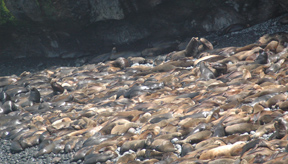Population Ecology
A population is a group of individuals of the same species living in the same region, such as the Steller sea lion. Population ecology is the study of how populations change over time and interact with their environment. Scientists at Wildlife Technology Frontiers in Seward, Alaska, study the population ecology of seals, sea lions, sea otters, sharks and many other upper trophic marine vertebrates. Wildlife Technology Frontiers researcher Dr. Markus Horning and his colleagues hope to extend their discoveries of why the endangered Steller sea lion population is not recovering after a sharp forty-year decline by knowing more about what is causing their death.
At the basic level, scientists studying animal population growth ask:
- How many are born?
- How many die?
- How many animals move into the same region?
- How many animals move out of the same region?
 Many factors influence population growth and decline. In a world of unlimited food and habitat, populations might grow indefinitely. However, resources such as food and habitat are limited. Animals compete for food and space, and amongst each other. A population’s size is limited by its carrying capacity, which is the maximum, stable population an environment can support over a long period of time. The carrying capacity indicates how well the environment is able to support animals with food, habitat, territory, and other resources. Carrying capacity can vary with time. Changing conditions including population size can lead to a change in carrying capacity.
Many factors influence population growth and decline. In a world of unlimited food and habitat, populations might grow indefinitely. However, resources such as food and habitat are limited. Animals compete for food and space, and amongst each other. A population’s size is limited by its carrying capacity, which is the maximum, stable population an environment can support over a long period of time. The carrying capacity indicates how well the environment is able to support animals with food, habitat, territory, and other resources. Carrying capacity can vary with time. Changing conditions including population size can lead to a change in carrying capacity.
 The number of individuals in a given area (population density) also affects population growth. Imagine two people on a deserted island trying to share one cookie. Each person gets half of the cookie resource. If you have four people sharing a cookie, each gets less than half of the cookie. At higher numbers of people, there is not enough of the cookie resource left to split, and individuals may not survive. For animals like Steller sea lions, the population density affects their birth, survival, growth, reproduction, and reproductive success.
The number of individuals in a given area (population density) also affects population growth. Imagine two people on a deserted island trying to share one cookie. Each person gets half of the cookie resource. If you have four people sharing a cookie, each gets less than half of the cookie. At higher numbers of people, there is not enough of the cookie resource left to split, and individuals may not survive. For animals like Steller sea lions, the population density affects their birth, survival, growth, reproduction, and reproductive success.
In marine systems the relationships amongst animals, their food resources, and other animals are often complex (and difficult to see underwater). This makes finding a culprit for Steller sea lion deaths tricky. For example, some scientists believe the Steller sea lion decline may have resulted from competition with humans for fish. But to discover what influences the number of fish, researchers must first understand the food these larger fish feed on: tiny, floating animals and small fish (zooplankton). These tiny animals and small fish are dependent on the number of small floating plants (plankton) they eat. The plankton rely on the sun and certain ocean conditions for food. All of the organisms in this food web play a role in transferring energy in the form of food to Steller sea lions, which makes it difficult to point to a cause. Scientists are not yet clear which of multiple factors may have been responsible for the population decline. And the interplay of these factors may have changed now that there are far fewer Steller sea lions. Studying population ecology is critical for understanding and managing animal populations such as the Steller sea lion.